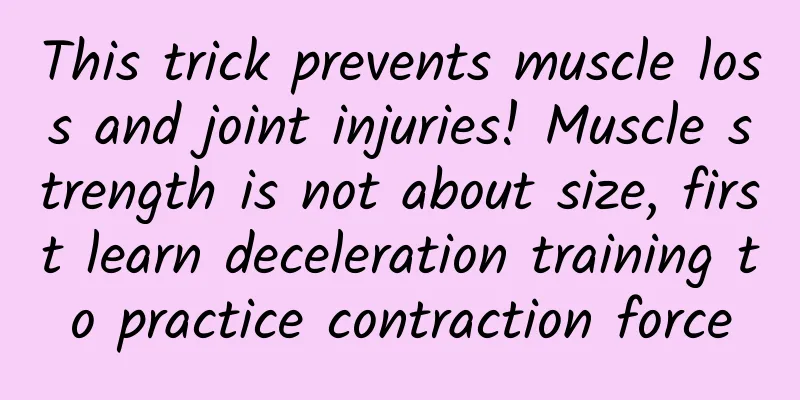This trick prevents muscle loss and joint injuries! Muscle strength is not about size, first learn deceleration training to practice contraction force

|
If you want to live long, stay active and healthy until old age, you must continue to exercise! Muscle strength will naturally deteriorate if it is not exercised. In addition, the older you get, the faster you lose muscle. There is a direct relationship between joint wear and tear and muscle strength. Rehabilitation specialists will teach you how to use "deceleration training" to enhance motor function, protect joints, and avoid strains, sprains, and joint injuries. Why not follow along and learn! Muscles are not trained for "size", but for "contraction force" "Strength training" does not mean that everyone should develop obvious muscles like athletes; the main purpose of muscle strength training is to avoid the degeneration caused by aging, which affects the motor functions of various body movements. Therefore, a very important concept is: muscles are not trained to increase their "size", but to increase their "contractile strength"! There are three ways of muscle contraction, including: concentric contraction, isometric contraction and eccentric contraction, that is, the change in length of the muscle during contraction. Concentric contraction shortens the length, isometric contraction keeps the length unchanged, and eccentric contraction lengthens the muscle. Three types of contraction determine your mobility These three types of muscle contraction have different meanings and functions in daily life, which are explained as follows: ●Centripal contraction: gives an object a velocity. For example: throwing things, kicking things, jumping up, etc. ●Isometric contraction: Maintain posture. For example: holding a child, carrying a basket of vegetables, standing still, etc. When the body is in these static postures, the muscles still need to continue to contract. ●Eccentric contraction: the action of deceleration and buffering. For example: squatting down after jumping up, slowing down and stopping after sprinting, decelerating and retracting the shot after accelerating the ball, raising things in your hands and then slowly putting them down, etc. There are three ways of muscle contraction, including: concentric contraction, isometric contraction and eccentric contraction, that is, the change in length of the muscle during contraction. Concentric contraction shortens the length, isometric contraction keeps the length unchanged, and eccentric contraction lengthens the muscle. In daily life, these three muscle contraction modes are very important, affecting the most basic human mobility and none of them can be missing. Muscles are most susceptible to injury when they are stretched Among the three muscle contraction modes mentioned above, "eccentric contraction" is most closely related to the occurrence of sports injuries. Rehabilitation specialist Tu Liwen teaches training movements in her new book "The Complete Book of Sports Function Restoration", which are all "deceleration training", that is, "eccentric contraction ability" plus "deceleration skills". The purpose is to allow the muscles to lengthen and slow down slowly in a controlled manner without being strained, so that the deceleration energy can be slowly absorbed and released. If the muscles cannot extend slowly, the energy of the impact (such as landing, sudden stop, turning, etc.) cannot be released properly, which can easily tear and strain the muscles and tendons, and even cause rupture and wear of joint ligaments or cartilage. In real life, it is not difficult to lift something, but it is difficult to put it down slowly. Being able to lift it but not being able to put it down is the main cause of injury. Imagine that when you jump high, the quadriceps on the front of the thigh need to contract concentrically (muscle shortening), but when you land, the quadriceps need to contract eccentrically, that is, the muscle length needs to be lengthened, and the muscle must maintain a certain tension at the same time. At this time, there are three situations that lead to injury: (1) If the length of the quadriceps muscle cannot be slowly extended, the reaction force of the ground on the feet when landing will tear the quadriceps muscle and cause strain. (2) Although the muscles are stretched, they cannot maintain a certain tension to withstand the body's gravitational acceleration. As soon as the feet touch the ground, the knee joints will bear the impact of gravitational acceleration, causing joint damage, and even the knee joints may directly hit the ground. However, this is a more extreme phenomenon. (3) The most common situation in real life is the third one, that is, although the length of the quadriceps has increased, it is not long enough. Although the quadriceps has maintained some tension, it is not enough. This will strain the muscle tendons and impact the knee joint. Over time, it will not only lead to tendon disease, but also cause joint degeneration and inflammation. In fact, there are many deceleration movements not only during sports, but also in daily life. It is because these movements are not performed well enough that so many strains, sprains and joint injuries occur. Even professional athletes, many people are injured because of poor deceleration. Not only athletes, but ordinary people need to avoid various injuries caused by "movement". Deceleration training is an important training to prevent injuries and maintain mobility. No matter how strong your muscles are, they can’t protect your joints The benefit of deceleration training is that it allows the muscles to slowly stretch and maintain sufficient tension through eccentric muscle contraction training, avoiding muscle and tendon strain, reducing impact on joints and avoiding wear and tear. Good deceleration training can significantly reduce damage to the musculoskeletal system, including avoiding muscle strain, reducing tendon inflammation, slowing joint degeneration, and reducing the burden on bones. It can not only prevent sports injuries, but also reduce the incidence of degenerative arthritis. The key to eccentric contraction training is "slow". The slower you go, the better the effect of the eccentric contraction training will be. The "deceleration technique" mainly focuses on the relative position of the body's center of gravity and the joints. If the body's center of gravity is not in the right place, or the offset between adjacent joints is too large, it will also cause damage to the muscles, bones and joints. Therefore, the focus of training is not only "slow" (deceleration), but also "stable", not "fast" and not "biased". The following training focuses on deceleration training of muscle "eccentric contraction", which helps to avoid muscle and tendon strain and reduce impact wear on joints, that is, the main purpose is to "prevent injuries": Training exercises - waist, lower back 【Upper body rotation strengthening training】 ★Kneeling position, turn around and pull down
2. Use your abdominal muscles to pull the elastic band diagonally to the lower left (about 1 to 2 seconds), and then slowly return to position 1 (about 4 to 6 seconds). 《Point》: Use the power of your body's rotation to drive, not your arms. ★Standing turn and pull up Other postures to do this exercise can also be done in a sitting position. 《Point》: Use the power of your body's rotation to drive, not your arms. 1. Stand with your feet shoulder-width apart; step firmly on the middle of the elastic band with your right foot, bend your upper body slightly to the right and forward, stretch your arms, and hold both ends of the elastic band. 2. Rotate your upper body to the left, and pull your hands upward to the left (about 1 to 2 seconds), and then slowly return to position 1 (about 4 to 6 seconds). Hip (hip joint) Hip extension strengthening exercise ★ Lunge and then lift your legs 1. Stand in a lunge with your left foot in front and right foot behind, with your knees slightly bent; wrap the elastic band around your right foot (back foot) and step firmly on both ends with your left foot (front foot). 2. Bend your upper body slightly forward, place your hands on your left thigh, and keep your center of gravity stable. 3. Lift your right foot backward, use your gluteal muscles to lift your thigh backward and upward (about 1 to 2 seconds), and then slowly return to position 2 (about 4 to 6 seconds). 《Point》: Use the strength of your hip muscles, keep your upper body straight, and do not bend your waist. If your body stability is poor, you can hold on to the table or wall with both hands. Hip abduction strengthening exercise ★Crab walk 《Check》: During the movement, be careful not to twist your pelvis and not to bend sideways or hunch over your upper body. 1. Stand with your feet shoulder-width apart, hands on your hips, and wrap the elastic band around your thighs. 2. Slightly squat with your knees, lift your right foot, and take a big step to the right. 3. Keeping your knees slightly bent, take a small step to the right with your left foot, and then a large step to the right with your right foot. ※After walking about 5 steps, switch sides and repeat the same action. 《Point》: The lower the part you wrap around, the more difficult it is. For example, wrapping around the calf will be more difficult than wrapping around the thigh. |
Recommend
Experts remind: Beware of the dangers of chronic adnexitis
The incidence of chronic adnexitis among female f...
Why do women feel cold during menstruation? How to regulate their health?
Many female friends find that they are very afrai...
What is the cause of Bartholinitis
For our female friends, Bartholinitis is a very c...
Care for cervical precancerous lesions is very important
Cervical precancerous lesions have been on the ri...
Why does incomplete abortion occur?
Incomplete abortion means that the embryonic sac ...
What are the health care methods after abortion?
After abortion, many patients are very weak, so i...
Overweight to over 100! Bariatric surgery: a two-pronged approach
Obesity is the root of all diseases; obesity is t...
Best hospital for the treatment of uterine effusion
Which hospital is good for treating uterine effus...
Can female Bartholinitis really be cured?
Bartholinitis is a disease that women are prone t...
What kind of salt is good for treating uterine fibroids?
Uterine fibroids are one of the most common gynec...
Things that can cause miscarriage if a pregnant woman touches them
Pregnant women may experience miscarriage if they...
What tests should be done for cervical warts
Can cervical warts be detected by blood tests? Bl...
Are cervical warts fatal?
In life, I believe everyone has had such an exper...
Several treatment methods for irregular menstruation that everyone needs to know
In real life, most female friends suffer from men...
What is the cause of uterine cyst?
Treatments for uterine cysts include medication a...









